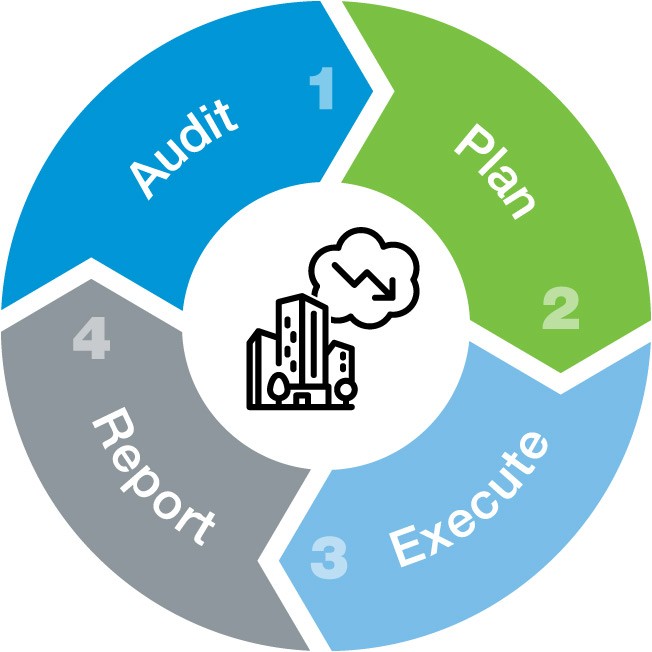In an era where sustainable practices are integral to business success, the pursuit of decarbonization has emerged as a strategic imperative for corporations. Facility managers are now being tasked with learning and navigating the complexities of this energy transformation so business goals can be met. This blog is aimed at illuminating the path to successful decarbonization, empowering you to lead your organization toward a more energy-efficient and low-carbon future.
The Decarbonization Launchpad
Before delving into the practical steps, it’s essential to grasp the concept of decarbonization and its significance. As a facility professional, your role drives change. Embrace a holistic perspective that encompasses energy efficiency enhancements, integration of renewable resources, and behavioral shifts throughout operations – all crucial ingredients for a successful decarbonization plan.
How to start your decarbonization journey
- Understand your energy data through a commercial energy audit
- Establish decarbonization goals – short-term and long-term
- Build a decarbonization plan and execute on it
- Track, analyze and report on your decarbonization efforts

Commercial Energy Audit
Undertaking a commercial energy audit is a critical first step toward achieving energy efficiency and decarbonization goals. Before making any changes to your business's energy usage, it’s important to benchmark current consumption and usage patterns. Conducting a benchmark analysis can help identify areas of improvement across business processes and facilities. This analysis should focus on tracking energy usage, identifying energy-intensive processes, and assessing potential savings opportunities.
To conduct a thorough audit of your company, it's important to include an energy efficiency assessment. This will examine your current energy usage and help identify areas where your company can make necessary improvements to save energy. Upgrading building management systems or implementing other efficiency measures are some of the actions that can be taken after this assessment. Prioritizing and implementing energy-efficient practices can help reduce energy consumption, lower energy costs, and contribute towards long-term energy success.
Develop Your Facility’s Decarbonization Goals
To develop an effective decarbonization plan for your business, it's vital to set an overarching goal of reducing carbon emissions while simultaneously addressing environmental and economic concerns. To achieve this goal, it's recommended that your plan includes both short-term and long-term goals, each with specific timelines, budgets, and assigned responsibilities. Short-term goals can deliver immediate carbon emission reduction benefits, while long-term goals create a roadmap to sustainable practices, like renewable energy use.
Short-term goals
|
Long-term goals
- Ensure supplier contracts are accurate and favorable
- Integrate renewable energy into your energy mix
- Benchmark and monitor energy metrics and carbon emissions
- Establish sustainability reporting criteria and communication plan
- Set carbon mitigation goals and monitor environment impact
- Engage suppliers and help them adopt more sustainable practices
It's essential to customize your decarbonization goals based on the unique requirements and limitations of your company while ensuring that they remain measurable and achievable. Therefore, a successful decarbonization plan should balance the value it delivers with available resources.
Blueprint for Implementation: Decarbonization Plan in Action
With energy baselines established and goals in sight, the next phase involves translating plans into action. This may involve changes to equipment, processes, or behaviors throughout the organization. Identifying energy-efficient technologies, evaluating renewable energy solutions, and prioritizing initiatives through cost-benefit analyses become pivotal steps.
Energy-efficient technologies: Sourcing and implementing cutting-edge technologies can drive energy efficiency within your facilities. This entails identifying solutions that align with your organization's unique needs and objectives. Energy-efficient technologies could range from advanced lighting systems and intelligent HVAC controls to smart building automation systems that optimize energy usage.
Integrating renewable energy solutions: There are many programs and products available helping businesses transition into renewable energy. Our team of consultants can work with you to create a plan tailored to your business’s specific needs, whether that includes the installation of solar panels, the implementation of microgrids, or the installation of electric vehicle (EV) charging stations at your facilities. Additionally, we offer options to harness renewable energy credits from external sources and explore community solar opportunities.
Prioritizing initiatives through Cost-Benefit analyses: As a savvy facility professional, you understand that every decision must be rooted in a solid cost-benefit analysis. Prioritize energy-saving initiatives based on their potential for significant impact and return on investment. This might involve considering the initial capital investment required, operational savings, and the projected reduction in carbon emissions.
Effective and adaptable project management: The decarbonization journey is an evolving one. Business and market conditions, technological advancements, and regulatory changes all contribute to a dynamic landscape. Ensure that your decarbonization plan is adaptable and can evolve alongside these changes. Regularly review and adjust strategies to remain aligned with the latest developments. Project management and coordination will allow for a seamless transition to a low-carbon future. This necessitates setting clear goals and timelines, allocating resources appropriately, and coordinating efforts with various stakeholders to achieve successful implementation.
Advancing with Technology: Tracking and Optimizing
To ensure success in sustainability efforts, it is essential to analyze your energy data, assess progress through benchmarking, and report greenhouse gas (GHG) emissions. Effective communication should involve providing a clear explanation of your sustainability plan, outlining carbon reduction goals, and reporting specific GHG emissions metrics.
However, many organizations lack the internal expertise and data analytics capabilities required for the level of reporting necessary. To gain a significant competitive advantage, it is advisable to employ a comprehensive software platform. Such a platform offers a range of powerful energy management tools that not only optimize corporate energy usage and identify cost-saving opportunities but also measure scope 1, 2, and 3 GHG emissions. Furthermore, it facilitates better procurement and sustainability decision-making and assists in meeting GHG reporting mandates.
The process does not end with setting goals and executing. A key step in successfully decarbonizing is optimization. There is plenty of important work to be done, such as addressing stakeholder questions and resolving any issues, checking for accuracy, measuring and verifying costs and savings, reviewing and assessing future goals and plans. As business and market conditions change over time, you may need to tweak strategies, modes of operation, or analytical outputs. This ongoing review and process planning helps re-tune your strategies in a highly dynamic market with rapidly changing technology, policy, regulation, and supply and demand fundamentals.
Decarbonizing a Fortune 500 company's facilities is a remarkable endeavor, blending environmental stewardship with operational excellence. By embracing the guidance provided in this post, you have the tools to initiate change that not only reduces carbon emissions but also enhances resource efficiency and resilience. As you embark on this journey, remember that each step taken towards decarbonization is a step towards a more sustainable future for your organization and the world at large.
By leveraging advanced technology, market insights, and deep expertise, Usource helps businesses of all sizes optimize their energy usage, reduce costs, and minimize their environmental impact. Whether you're looking to develop and execute a sustainability strategy, integrate renewables into your business’ procurement process, or implement energy-efficient technologies, Usource has the expertise to help you achieve your goals. With its customer-centric approach and commitment to excellence, we are a trusted partner for businesses across a wide range of industries.


